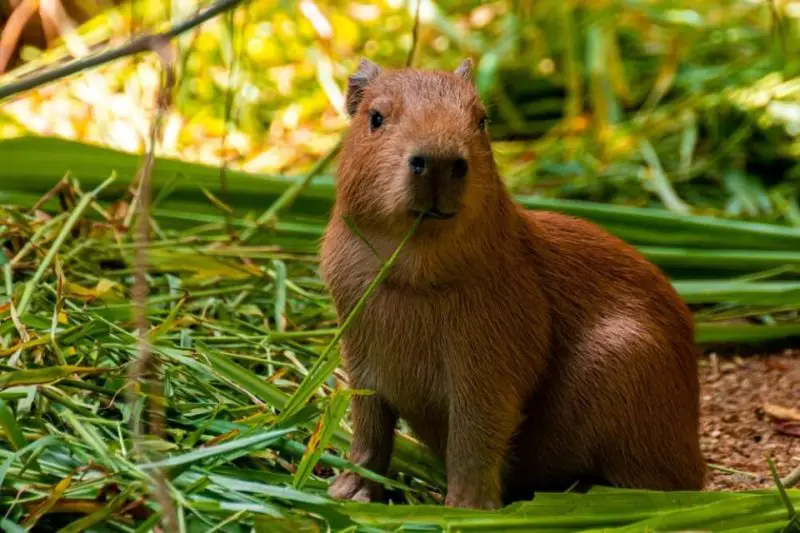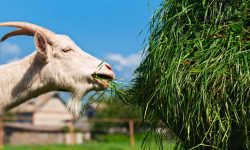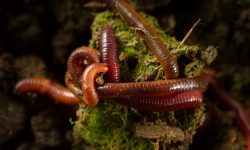The capybara, the world’s largest rodent, is one of nature’s most fascinating herbivores. Native to South America, these semi-aquatic mammals live near rivers, lakes, and wetlands where lush vegetation is abundant. Known for their calm temperament and social behavior, capybaras spend much of their day grazing — but what exactly do these gentle giants eat?
Unlike many rodents, capybaras have a strictly plant-based diet. They are herbivores, meaning they rely entirely on vegetation to survive. Their diet consists mainly of grasses, aquatic plants, and fruits. They also exhibit a unique digestive process that allows them to extract maximum nutrition from fibrous foods.
In this guide, we’ll explore 20 foods capybaras love the most, showing what keeps these remarkable animals healthy, hydrated, and thriving in the wild and in captivity.
Understanding the Capybara Diet

Capybaras Are Strict Herbivores
Capybaras feed almost exclusively on plant matter. Their diet consists of a variety of grasses, aquatic plants, reeds, fruits, and bark. They have evolved to consume high-fiber vegetation that most other animals can’t digest efficiently.
Their long, sharp incisors grow continuously, allowing them to chew through tough plants and bark without wearing down their teeth. This adaptation is essential for processing the fibrous grasses that make up the bulk of their diet.
A Unique Digestive System
Capybaras are hindgut fermenters, similar to rabbits and horses. Their large cecum contains bacteria that break down cellulose from plants, allowing them to absorb nutrients from otherwise indigestible fiber.
Interestingly, capybaras practice coprophagy — the act of eating their own feces. This may sound odd, but it’s crucial for their health. By re-digesting their food, they extract additional nutrients and beneficial bacteria that support their digestive system.
Water and Grazing Habits
Because capybaras are semi-aquatic, they often feed near water. They graze early in the morning and late in the evening when temperatures are cooler, sometimes spending hours eating.
Their diet changes slightly with the seasons. During the wet season, they eat soft, lush grasses. In the dry season, when grass becomes scarce, they turn to bark, reeds, and aquatic vegetation for sustenance.
20 Foods Capybaras Love the Most
1. Grasses
Grasses form the core of a capybara’s diet, accounting for more than 70% of their daily intake. They graze on soft, tender blades of native species such as Bermuda grass, Paspalum, and switchgrass. These plants provide the high fiber necessary for proper digestion, along with moderate protein and trace minerals.
Capybaras spend hours every morning and evening grazing, using their sharp incisors to cut through blades efficiently. They prefer young shoots over mature grass because younger growth contains more moisture and is easier to chew.
In captivity, caretakers often replace wild grasses with timothy or orchard hay, ensuring a steady source of fiber that mimics the natural grazing environment and prevents tooth overgrowth.
2. Aquatic Plants
Aquatic vegetation like water hyacinth, duckweed, and water lilies plays a major role in the capybara’s diet. These soft, water-rich plants grow abundantly along riverbanks, marshes, and ponds — exactly where capybaras spend most of their time.
The moisture content in these plants keeps capybaras hydrated, while the nutrients support healthy skin and coat condition. Some aquatic plants also contain calcium and potassium, aiding in bone and muscle maintenance.
Capybaras often enter the water to graze, using their webbed feet for balance as they tug floating plants with their teeth. It’s not just feeding — it’s part of their cooling and social routine.
3. Reeds and Rushes
During the dry season, when grasses wilt, reeds and rushes become essential fallback foods. These tall, fibrous plants grow near wetlands and serve as a reliable source of roughage even when other vegetation dries out.
Although they contain fewer nutrients than fresh grasses, reeds help maintain healthy digestion through high fiber content. Chewing on these stalks also strengthens jaw muscles and wears down continuously growing teeth.
The resilience of reeds makes them a survival staple for wild capybaras during droughts or environmental stress, showcasing their adaptability.
4. Hay
In captivity, hay is the nutritional backbone of a capybara’s diet. Types such as timothy, orchard, and meadow hay closely resemble the fibrous composition of natural grasses, providing consistent energy and digestive support.
The coarse texture of hay keeps teeth at the right length and promotes proper gut function by ensuring a steady intake of fiber. Regular chewing also satisfies their natural grazing instincts.
Offering hay year-round, especially during seasons when fresh greens are limited, helps captive capybaras maintain a balanced, stress-free feeding routine.
5. Water Hyacinth
Water hyacinth is one of the most popular aquatic plants among capybaras. Its broad, tender leaves and soft stems are easy to bite through and rich in vitamins A and C, supporting immune and skin health.
This floating plant also has a cooling and hydrating effect, especially beneficial in tropical climates. Capybaras can often be seen lounging in shallow water while nibbling on these plants.
In captivity, caretakers must monitor the amount fed, as water hyacinth can absorb toxins from polluted ponds. Only plants grown in clean, freshwater systems should be offered.
6. Bark and Twigs
When green vegetation becomes scarce, capybaras resort to chewing tree bark and twigs. This not only provides fiber and trace nutrients but also helps maintain proper tooth wear — an essential part of rodent dental health.
Bark from trees such as willow, aspen, or palm contains minerals like calcium and magnesium, which support bone and muscle health. The rough texture also satisfies their need to gnaw regularly.
This behavior often peaks in the dry season, showing the species’ remarkable ability to adapt to changing food availability.
7. Fruits
Capybaras enjoy a variety of fruits, including melons, apples, bananas, and berries. Fruits are naturally sweet and packed with vitamins, antioxidants, and hydration, making them an occasional but nutritious supplement.
In the wild, they consume fallen or overripe fruit, gaining energy from the natural sugars while aiding seed dispersal. This makes them important contributors to their ecosystem’s plant regeneration.
In captivity, fruits should be given sparingly to avoid digestive issues or obesity. A few slices a few times a week are more than enough to satisfy their cravings.
8. Vegetables
Vegetables like carrots, kale, lettuce, and cucumbers are excellent for balancing the diet of captive capybaras. They supply essential vitamins and minerals — particularly vitamin A, potassium, and fiber — which support organ and skin health.
Root vegetables such as sweet potatoes and carrots provide slow-burning carbohydrates for sustained energy. Leafy greens, on the other hand, promote hydration and digestion.
Rotating vegetable options prevents monotony and ensures capybaras receive a wide range of nutrients while mimicking seasonal variety in the wild.
9. Corn Stalks and Leaves
Capybaras occasionally venture into crop fields, where they chew on corn stalks and leaves. They prefer the fibrous green parts of the plant over the corn kernels, which are too starchy for their digestion.
These stalks offer texture and cellulose that stimulate chewing and aid in tooth wear. Their mild flavor also appeals to grazing instincts.
While beneficial in small amounts, corn plants are typically a minor food source, as capybaras rely mostly on wild grasses and wetland vegetation in their native habitats.
10. Sugar Cane
Sugar cane is a favorite occasional treat for capybaras because of its sweet flavor and juicy texture. It provides instant energy through natural sugars and also helps grind down their ever-growing incisors.
Wild capybaras sometimes chew on native grass stems that have similar fibrous qualities. In managed care, small pieces of sugar cane can be provided as enrichment food.
However, excessive consumption can lead to digestive upset or weight gain, so it’s best offered only occasionally and in limited portions.
11. Lotus Plants
Lotus plants thrive in shallow water and provide capybaras with both nutrition and hydration. The stems and leaves are soft, easy to chew, and rich in minerals and antioxidants.
Feeding on lotus vegetation helps maintain hydration during warm weather, as these plants are naturally high in water content.
Capybaras often submerge themselves in ponds to graze on lotus, blending feeding with their love for water — a behavior that keeps them cool and safe from predators.
12. Bamboo Shoots
Young bamboo shoots are tender, fiber-rich, and low in fat, making them an excellent addition to a capybara’s plant-based diet. They’re easily digestible and provide beneficial minerals such as manganese and potassium.
Capybaras in tropical regions naturally encounter bamboo and feed on its shoots during growth seasons. The crisp texture also satisfies their instinct to gnaw.
For captive animals, bamboo provides both nutrition and chewing enrichment, preventing boredom and dental overgrowth.
13. Water Lettuce
Water lettuce is another aquatic plant frequently eaten by capybaras. Floating on ponds, it has spongy, nutrient-filled leaves that are high in calcium and water.
Its gentle flavor and soft structure make it one of the easiest plants for them to consume. The moisture content also contributes to internal cooling and hydration.
As with other aquatic plants, cleanliness is key — it should come from pesticide-free sources to avoid contamination.
14. Papaya
Papaya is one of the capybara’s most-loved tropical fruits. It provides vitamins A and C, which boost immune function and support skin and vision health.
The fruit’s soft texture makes it easy to chew and digest, even for older animals. Its natural enzymes also aid in breaking down fibrous plant matter.
In captivity, papaya slices are often used as training rewards or enrichment treats — tasty yet nutritious when served in moderation.
15. Spinach and Kale
Dark leafy greens such as spinach and kale are nutritional powerhouses, packed with calcium, iron, and antioxidants that promote bone and immune health.
They’re an excellent source of variety for capybaras, helping to balance out the high-fiber but low-mineral content of grasses.
However, these greens should be fed alongside lower-oxalate options like romaine lettuce to prevent excessive calcium binding and maintain healthy digestion.
16. Sweet Potatoes
Sweet potatoes provide complex carbohydrates and beta-carotene, making them a valuable energy source for capybaras. They’re also rich in fiber and easy to digest.
In captivity, they can be offered raw (shredded) or lightly cooked to soften the texture. The sweet flavor encourages appetite and dietary variety.
Feeding sweet potatoes occasionally ensures energy balance without adding too much sugar to their diet.
17. Cucumbers
Cucumbers are a perfect summer food for capybaras. With their high water content and refreshing taste, they help maintain hydration in hot weather.
They’re also low in calories and rich in trace minerals like potassium, supporting heart and muscle function.
Sliced cucumbers make an ideal daily vegetable supplement, providing crunch, moisture, and digestive support.
18. Apples
Apples are a crunchy, nutrient-rich snack that capybaras enjoy both in the wild and in captivity. Their sweetness provides quick energy, while the texture aids in dental cleaning.
They contain vitamins A, B, and C, which support immune function and coat shine.
Seeds, however, should always be removed before feeding, as they contain small amounts of cyanogenic compounds harmful to animals.
19. Clover
Clover grows abundantly in the wetlands and grasslands where capybaras live, making it a readily available and nutrient-dense food source.
It’s high in protein, calcium, and fiber, which promotes muscle development and digestion. The slightly sweet taste also makes it one of their preferred natural forages.
Capybaras often seek out clover blossoms during morning grazing sessions, enjoying both the tender leaves and flowers.
20. Watermelon
Watermelon is one of the most refreshing treats for capybaras, especially in the peak of summer. Its high water content helps maintain hydration and regulate body temperature.
The juicy red flesh provides a light source of sugar and vitamin C, while the rinds can be chewed for texture and fiber.
Small chunks of watermelon are perfect occasional treats, combining hydration, nutrition, and pure enjoyment — a favorite among captive and wild capybaras alike.
Frequently Asked Questions (FAQs)
Do capybaras eat meat?
No, capybaras are strict herbivores. They eat only plants, grasses, and fruits — never meat or insects.
How often do capybaras eat?
Capybaras graze for several hours a day, mostly during dawn and dusk. In captivity, they should have constant access to fresh hay or grass.
Do capybaras need water to eat?
Yes, they often feed near or in water. Aquatic plants make up part of their diet, and water helps them stay cool and hydrated.
Can capybaras eat human food?
Only certain fruits and vegetables are safe for them. Avoid processed or salty foods, as these can harm their digestive systems.
Why do capybaras eat their own feces?
This behavior, called coprophagy, helps them reabsorb nutrients and beneficial bacteria for better digestion and health.
Conclusion
Capybaras are gentle, social animals with a simple yet fascinating diet built entirely around plants. From lush grasses and aquatic plants to fruits and vegetables, every bite they take supports their unique lifestyle as semi-aquatic herbivores.
Their efficient digestive system, constant grazing habits, and preference for fibrous foods make them one of nature’s best-adapted vegetarians. Understanding what capybaras eat not only helps in caring for them in captivity but also deepens appreciation for how these peaceful creatures thrive in the wild.
Whether they’re nibbling grass by the riverbank or enjoying a juicy watermelon treat, one thing is clear — capybaras truly are nature’s happiest grazers.






